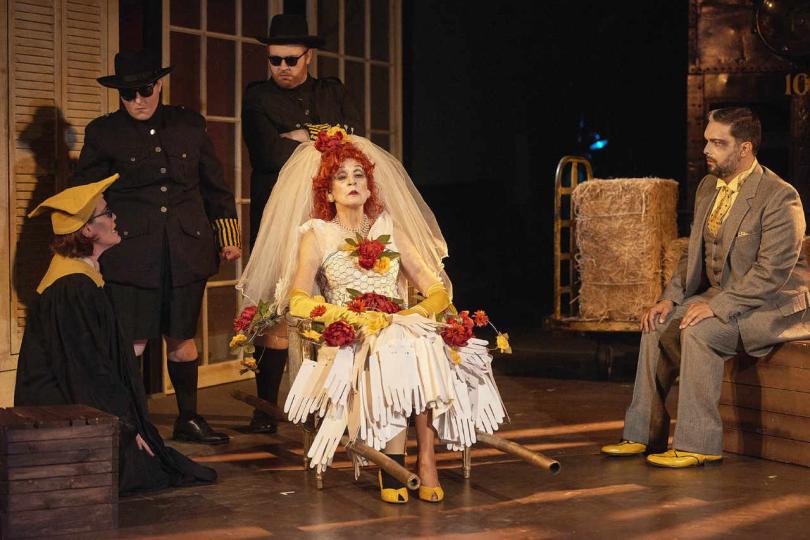An Intimate Acquaintance

Years in the making, Frank Theater’s performance of Friedrich Dürrenmatt’s The Visit encourages reflection and introspection. The stage is nestled within the Minnesota Transportation Museum, which could be a bit hockey, but is instead one of the best things about the production. The smell of the old metal, the clinging dirt -- things in the museum have been used, and it’s a great setting for the worn people of Güllen and Claire Zachanassian’s revenge.
Comprised of a very large ensemble cast and clocking in at nearly 3 hours, Friedrich Dürrenmatt’s The Visit (translated by Maurice Valency) is epically small, meaning that it tries to explore the trickier parts of human nature through a seemingly small case: at the age of 17, Claire Zachanassian’s lover Anton (Mark Rhein) disavowed their illegitimate child, leaving Claire (Katherine Ferrand) to be chased out of Güllen (their small hometown) and open to the world’s caprese. While Claire eventually manages to claw herself out of whoredom proper, she uses her beauty and cunning to amass a very large financial empire. Forgetting their past indiscretions towards her and thinking only of the potential upside to her patronage, the townsfolk of Güllen wait with eager anticipation for her to save them. Like a vengeful angel, Claire returns to her mysteriously blighted hometown to smite those who harmed her and prove that humanity has a price. Promising to give the town and its inhabitants an inordinate amount of money (half to go to the town, half to be split evenly between all its inhabitants), Claire explains she has only one condition: they must kill Anton.
Creeping Yellow
While the first third of this production is a bit caricatured for my taste (particularly before the audience has grown accustomed to the more ghoulish makeup and the heady dialogue), the second two-thirds of the play pick up steam, with characters’ dilemmas and dialogue becoming more naturalistic and interesting. Even the townsfolk caricatures from earlier in the play soften and become more nuanced. Perhaps the best scene is close to the middle: after Claire’s offer to the townspeople (which they initially rebuff in the strongest terms) everyone starts to gather at Anton’s store. They start with simple purchases, and then escalate to more and more extravagant goods. Whole milk, white bread, imported tobacco, chocolate -- every luxury they have craved but denied themselves is suddenly available via credit. The town becomes alive with hopes of prosperity, refusing to reconcile that the money they are pre-spending demands the life of their friend. After all, “People die, not towns.” (Claire, Act II).
While initially Anton thanks the townspeople for his life, his dawning recognition of what it means for him is scary and potent. Kathy Kohl’s costuming is exquisite throughout (think any movie Johnny Depp has done in the last 15 years, mixed with a coat of grime unfit for HD), but in this scene the way she has developed the color yellow as its own character becomes clear. Claire and her manservant often wear this distinctive color, but it isn’t clear until this scene in Anton’s shop that its importance becomes clear: everyone polluted by Claire’s need gradually accumulates the color, finally culminating in everyone purchasing and wearing new yellow shoes. “A person can’t walk around forever in the same old shoes” (Woman 1, Act II) the townspeople explain to a stricken Anton. The new shoes can almost be overlooked, but whenever someone acts strangely towards Anton, the audience’s gaze, like Anton’s, immediately falls to their feet. It’s in those small glances at new clad foot after new clad foot that his fate becomes clear, both to him and to the audience.
#metoo #stopkavanaugh
Rhein’s performance throughout is kind and understated -- its hard to reconcile the changed and civic-minded adult Anton with the pictures Claire paints of a wild youth and his ultimate betrayal. This is one of the central tensions of the play -- Claire is clearly our protagonist, but she is so twisted, so cruel, that even though Anton did clearly make her life horrible, we are inclined to forgive him and punish her. Again.
In our current times of pussy-grabbing Presidents and Brett Kavanaugh’s seemingly inevitable accession to the highest court in the United States, Claire’s calls for justice have an immediacy that is almost as laughable as it is unbelievably sad -- I wonder if 1 million marks would be enough to buy justice for the women both of these men have been accused of assaulting? Ferrand does a commendable job with Claire, whose unforgiving speeches and upjumped manner of speaking might prove tricky for a less experienced actress. Ferrand does not make us love Clair but we are not supposed to. Justice shouldn’t depend on how likeable a woman is.
These sexual politics are also clear but not distractingly overt in the way that director Wendy Knox has gender-bent some of the roles. The Pastor (Vinecia Coleman), the Policeman (Marisa Carr), the Teacher/Professor (Heather Bunch), and the ensemble of women who play a cohort of elderly men (Katie Kaufmann, Charlotte Calvert, Chelsie Newhard, Kirby Bennett, Allison Witham) add a welcome layer of interest and depth to these roles. In particular, I found Heather Bunch’s Teacher moving. This is partially because the character himself is so well-developed in the script, and partially because Bunch seems to transmute his words through herself, giving the words a different kind of energy and importance. Her betrayal of Anton at the end is one of the most heartbreaking, and her ability to make the logic of murder sound justifiable makes the play function.
I would highly recommend The Visit -- the script, the acting, and the scenic and lighting design in the Minnesota Transportation Museum make it a standout performance. Wait until you see how they use some of the lights from the trains! The Visit runs until October 21.




